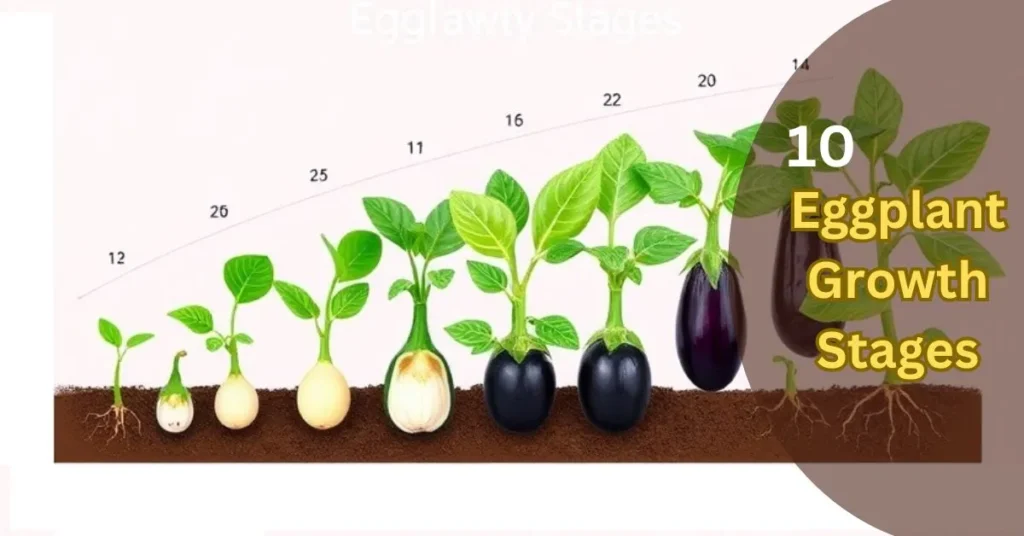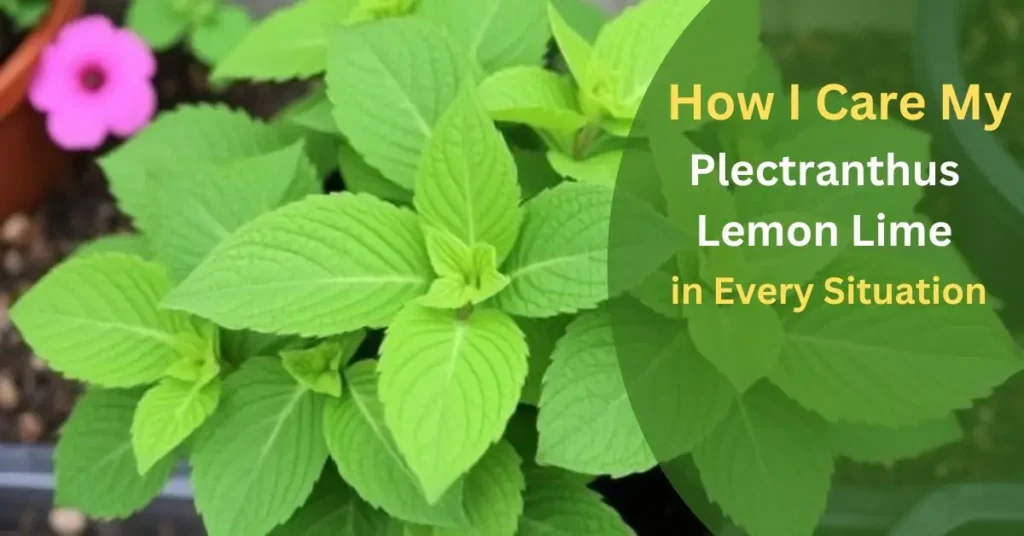A driveway is more than just a functional path—it’s a chance to make a captivating first impression. The journey begins with reimagining this essential space as part of a larger landscape that reflects your home’s warmth and style.
By adopting strategic landscaping ideas, such as the incorporation of vibrant perennials, annuals, and graceful ornamental grasses, you can create an entrance that feels both welcoming and elegant.
These elements not only complement your home’s character but also serve as a testament to your thoughtful design and personal taste. Adding water-wise xeriscaping can further elevate the space, offering a sustainable yet innovative touch. Each choice, from aesthetic appeal to functionality, can transform your driveway landscaping into something truly unique.
Imagine guests interacting with a space that feels carefully curated, with every detail contributing to the tone of elegance and charm. Whether you prefer lush greenery or a more minimalistic approach, this is an opportunity to let your blog-worthy ideas shine, ensuring your driveway stands out while enhancing the overall look of your property.
1. Design With Perennials and Annuals

Creating a stunning driveway entry begins with a design that combines the timeless charm of perennials and the seasonal vibrancy of annuals. By blending these plants, your landscaping remains both vibrant and colorful throughout the year.
Lavender and Daylilies serve as excellent choices for adding a lasting structure with seasonal blooms, while Petunias and Marigolds provide an immediate impact and allow for flexible, changeable designs. This thoughtful combination ensures your space stays lively, adapting to seasonal shifts and personal preferences.
Using perennials as a structural foundation, you can layer plants of varying heights, textures, and bloom times to craft a dynamic, cohesive landscape. For example, taller Lavender can anchor the backdrop while mid-height Daylilies fill in the middle.
Meanwhile, the bright hues of Petunias and Marigolds offer bursts of color at the edges. This strategy transforms your driveway into more than just a pathway—it becomes a reflection of your creativity and care.
2. Xeriscape Your Driveway Landscape
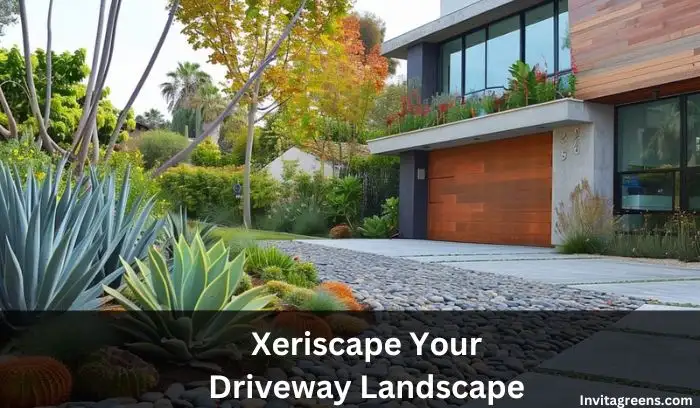
Xeriscaping is a landscaping philosophy that focuses on using drought-resistant plants and efficient irrigation to create a visually appealing and practical driveway landscape. This method not only helps reduce water usage but also minimizes maintenance needs, making it an attractive and sustainable choice.
By incorporating creative techniques, you can design a low-maintenance garden area that suits both arid and semi-arid regions while being easily adapted to various climates.
To maximize success, plan zones by grouping plants with similar water needs together, ensuring irrigation efficiency and conserving resources. Whether your goal is to create a beneficial and eco-friendly space or to simplify your gardening efforts, this approach ensures a cohesive and well-thought-out landscape design. The result is a driveway that not only enhances your home but also aligns with modern sustainable practices.
3. Use Ornamental Grasses for Elegance
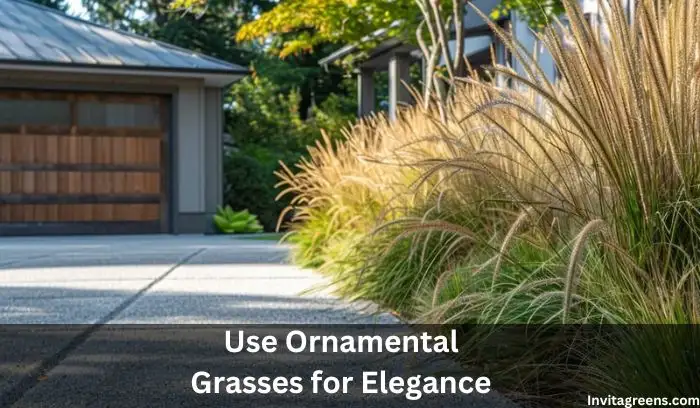
Incorporate ornamental grasses into your driveway landscape to add an element of elegance and sophistication while ensuring ease of maintenance and year-round interest.
Tall varieties like Miscanthus or Feather Reed Grass (Calamagrostis) can be planted on either side of your entrance to create an inviting gateway. Their height and form not only frame the driveway beautifully but also draw attention to the entryway, making a bold yet refined statement.
For a softer touch, use smaller grasses such as Blue Fescue (Festuca glauca) or Japanese Forest Grass (Hakonechloa macra) to edge the driveway.
These grasses bring a neat, orderly appearance and can effectively soften the hard lines of the pavement, enhancing the overall harmony of the space. This thoughtful arrangement combines aesthetic appeal with practical benefits, creating a landscape that balances natural beauty with function.
4. Layer Plants for Depth
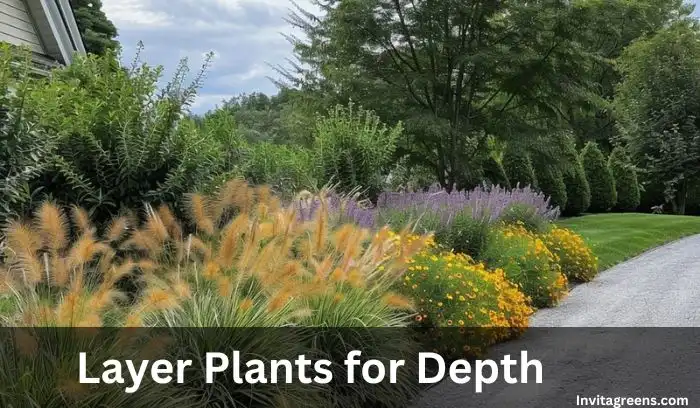
Creating depth in your driveway landscaping involves a thoughtful placement of plants with varying heights, textures, and colors to achieve a structured yet dynamic garden look.
Start with the background layer, where tall trees or shrubs such as Arborvitae or Japanese Maples set the backdrop and provide a lush sense of privacy. These towering elements define the tallest layer, anchoring your design visually.
Move to the midground layer, which adds the bulk of visual interest. Here, perennials, medium-sized shrubs, or ornamental grasses like Hydrangeas work beautifully.
Finally, complete the front layer with lower plants such as annuals, ground covers, or low-growing perennials like Sedum or Creeping Thyme. This layering approach softens hard edges, creating a cohesive, inviting, and aesthetically pleasing design.
5. Experiment With Gravel Landscaping
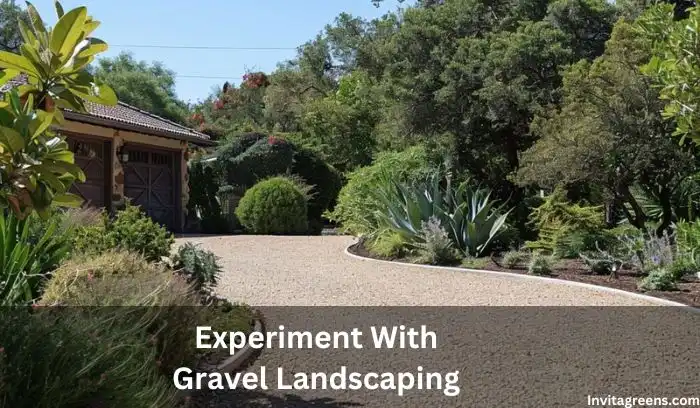
Gravel landscaping adds a sleek and elegant touch to driveways, combining practical benefits with timeless style. Its low-maintenance, durable surface complements a variety of plants and design styles, from modern to rustic.
With its range of colors, sizes, and textures, gravel offers endless customization to suit your home’s unique look. You can achieve a clean, uniform appearance or create visual interest by combining it with stepping stones or pavers.
When incorporating plants, choose species that are drought-resistant and thrive in well-drained soil. Succulents, ornamental grasses, and low-growing ground covers are perfect choices for this setting as they easily adapt and enhance the overall design. This thoughtful approach transforms a basic driveway into a functional yet visually appealing space.
6. Introduce the Concept of Rock Gardens
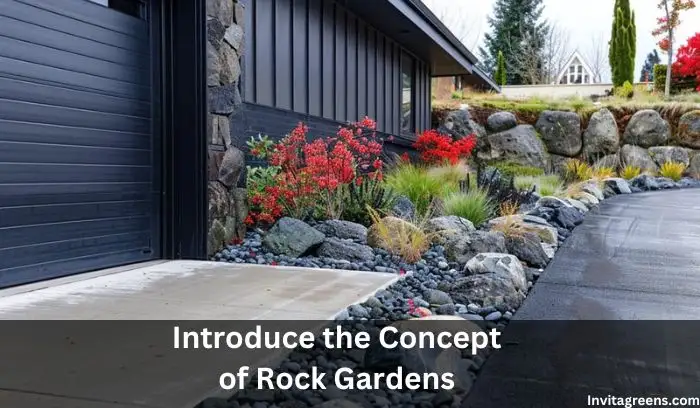
Rock gardens are a unique and captivating landscape element that work well in driveway areas, especially where conventional gardening can be challenging.
This design aims to replicate the raw beauty of natural landscapes, drawing inspiration from rugged terrains like mountains or deserts.Start by placing larger rocks to anchor the design, then layer with smaller stones and plants for added texture and appeal.
When choosing species, focus on those that thrive in well-drained soil and can handle harsher, sunnier conditions than an average garden bed. Alpine plants, succulents, perennials, and groundcovers are ideal choices to complete the look. This thoughtful approach creates a balanced, low-maintenance design that enhances the beauty of your outdoor space.
7. Create a Pollinator-Friendly Driveway
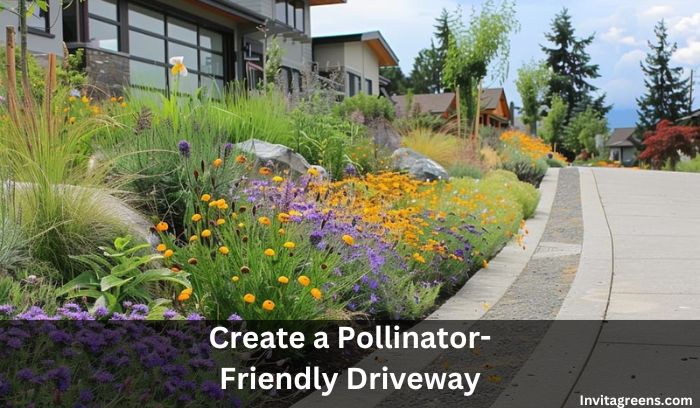
Transforming your driveway into a space that supports biodiversity and enhances its ecological health is not just rewarding but also visually appealing. By incorporating plants and flowers that attract bees, butterflies, hummingbirds, and other beneficial insects and birds, you can bring vibrant life and beauty to this often-overlooked area of your home.
Choosing native plants is particularly effective because they are well-adapted to the local climate and naturally attract pollinators. Adding coneflowers like Echinacea, fragrant lavender, and cheerful black-eyed Susans (also known as Rudbeckia) will not only create an attractive and colorful space but also serve as a haven for a variety of species.
To take it a step further, you can plant milkweed, which is essential for the survival of monarch butterflies, or experiment with a mix of Rudbeckia, Asclepias, and other choices suited to your region.
These plants will create a vibrant sanctuary where butterflies can thrive, and the gentle hum of bees and the flutter of hummingbirds can become a part of your daily experience. As someone who has incorporated these elements into my own garden, I can attest to how these additions have not only enhanced the beauty of the space but also fostered a deeper connection to nature.
8. Incorporate Arches and Trellises for Vertical Interest
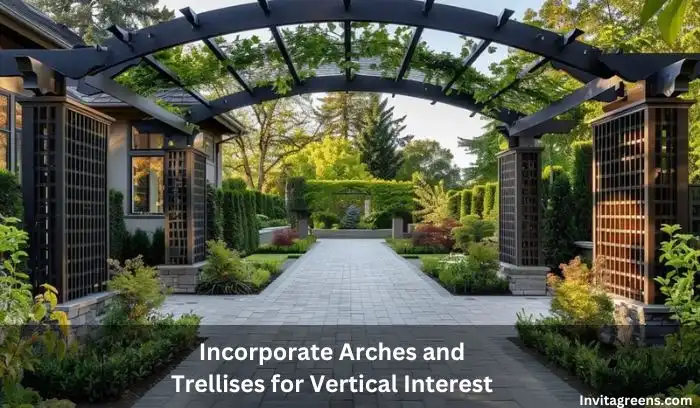
Adding arches and trellises to your driveway can transform its landscaping by creating a striking vertical dimension. These features provide a structured yet organic framework that enhances the overall design. Choose designs that complement your home’s architectural style and the surrounding landscape.
For materials, consider wood, metal, or vinyl, as each offers unique aesthetic appeal and varying levels of maintenance. Incorporating climbing plants, such as clematis with its vibrant flowers, or roses known for their beauty and fragrance, can make these elements stand out even more.
To suit your local climate and conditions, select plants that thrive in your area. Wisteria, with its dramatic blooms and strong growth, is an excellent option for adding elegance to your design.
The combination of these elements creates a harmonious balance, showcasing the versatility of well-chosen materials and the natural allure of plants. My personal experience in integrating these features revealed how much they elevate the appeal and functionality of any space.
9. Create Small Islands in the Driveway
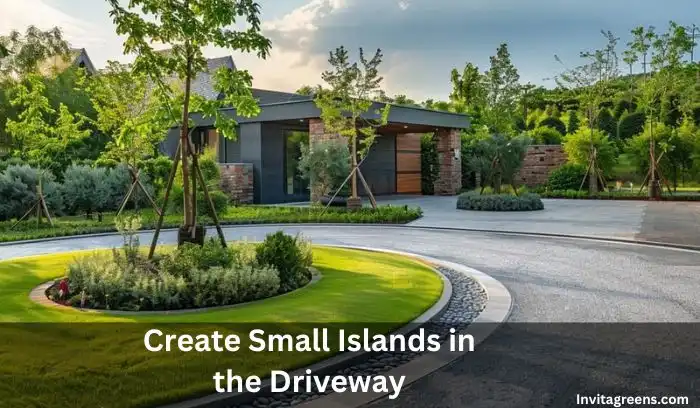
Adding small islands or planting beds to your driveway can transform its landscape, breaking up large surfaces and creating visual interest. These islands are not just for aesthetics; they help in greening the space while also aiding stormwater management by reducing runoff.
Consider focal points like hardscape features such as rocks, boulders, or decorative stepping stones to enhance their appeal. Integrating ornamental grasses, low-growing shrubs, or groundcovers can add texture and depth to the design.
When selecting plants, opt for those that are hardy and can thrive in specific conditions like sunlight, heat reflection from the pavement, or exposure to car-related pollutants.
Vibrant perennials are a great choice, and combining them with choices like grasses or shrubs can create a balanced, low-maintenance look. Through personal experience, integrating these elements brings life to otherwise dull areas and makes the driveway feel like a natural extension of the garden.
10. Install Water-Efficient Irrigation Systems
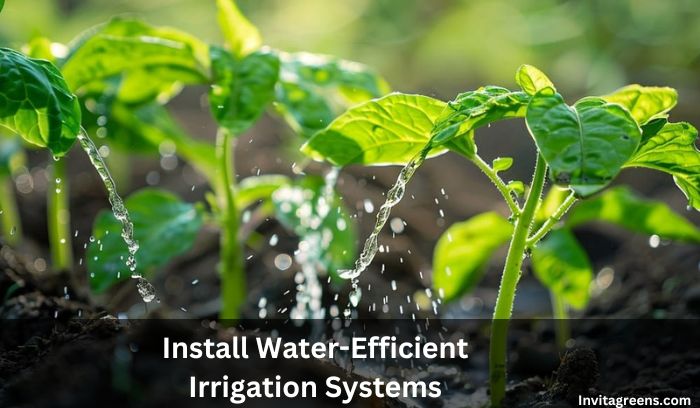
Using water-efficient irrigation systems in your driveway landscaping ensures your plants can thrive while reducing waste and conserving water. A drip irrigation system is an excellent choice for targeted watering, delivering water directly to the soil near the roots of your garden beds or individual plants.
This method minimizes waste and keeps your space neat by hiding the system under mulch, maintaining the aesthetic appeal of the landscape. I’ve found this approach works exceptionally well for compact or narrow areas where precision is key.
For larger areas or curved beds, soaker hoses are a highly effective option. They allow water to seep slowly along their length, providing a uniform supply to the base of plants. This method is simple to install and works well in spaces exposed to high sunlight or reflective heat from nearby surfaces. Combining either system with strategic plant placement can make a noticeable difference in how efficiently your landscape manages watering needs, saving time and resources.
11. Install Driveway Landscape Lighting for Improved Nighttime Safety and Visibility

Adding landscape lighting to your driveway not only enhances the beauty of your property at night but also significantly improves safety and visibility. By strategically placing lights along the path, you can guide vehicles and pedestrians, reducing the risk of accidents while creating a welcoming ambiance.
Using low-voltage or solar-powered pathway lights on the sides of your driveway clearly outlines the path and adds a soft, warm glow to the area. I’ve found that motion sensor lights are particularly helpful, offering both convenience and added security.
For a touch of elegance, spotlights can be used to focus on specific features such as trees, sculptures, or architectural elements of your home. If your driveway includes an entrance with a gate or pillars, installing post lights can make the space feel more inviting while enhancing safety. Combining these lighting techniques ensures that your driveway is both functional and visually appealing, making it a standout feature of your property.
12. Try Driveway Edging to Create a Well-Defined Boundary
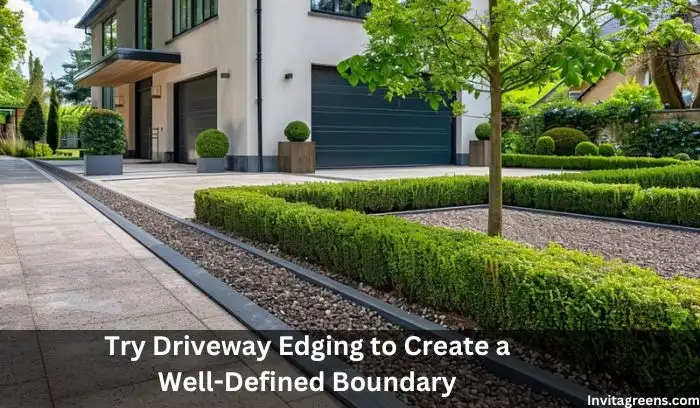
Adding edging to your driveway is a practical and stylish way to define its boundaries. It helps maintain clean lines and prevents the spread of lawn or garden materials onto the pavement, keeping everything neat and organized.
From my experience, driveway edging not only adds functionality but also enhances the overall look of the landscape, giving the area a polished feel. There are numerous materials you can choose from, such as brick, stone, concrete, metal, or even durable plastics.
Each option offers a unique aesthetic and can be selected to complement the style of your home and surroundings. Whether you prefer the rustic charm of stone or the modern appeal of metal, the right edging can tie the design together seamlessly and make a lasting impression.
13. Integrate Garden Art and Sculptures Into the Driveway Landscape
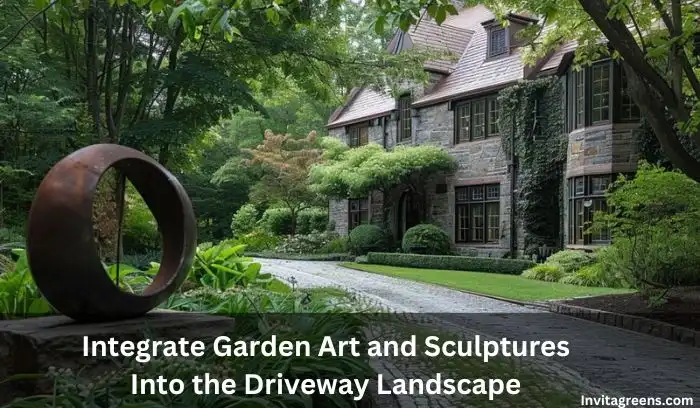
Adding art pieces and sculptures to your driveway landscape can bring a unique and personal touch to your property. These artistic elements act as focal points, enhancing the surrounding plantings while reflecting your style and interests.
Whether you prefer abstract designs, traditional statues, or decorative ornaments, the right choices can add depth and character to your space. I’ve found that carefully placed sculptures can truly transform the area, creating a balance between creativity and nature.
When selecting materials, options like bronze, stone, or weather-resistant metals are great for outdoor use. These materials are durable enough to withstand the elements and age gracefully in the garden setting.
Incorporating culturally significant pieces can also add meaning and uniqueness to the design. Combining art with landscaping creates an inviting and visually appealing environment for both residents and visitors.
14. Explore the Mediterranean Garden Style
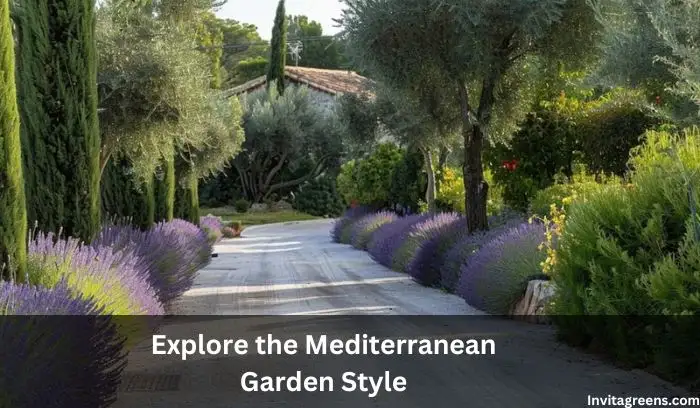
Transforming your driveway landscape into a Mediterranean garden style adds a sense of warmth, color, and timeless elegance to the space. This style is defined by its use of drought-tolerant plants, such as lavender, rosemary, olive trees, and cypress, which thrive in sunny conditions.
Incorporating an earthy palette with blues, silvers, and greens in your plant choices and hardscaping materials can beautifully echo the natural hues of Mediterranean landscapes.
This design blends formal and informal elements for a relaxed yet structured look. You can enhance the area with materials that bring out the natural charm of the environment while complementing the elegance of your home.
From my experience, combining hardscaping with carefully selected plants ensures the garden is both visually appealing and easy to maintain, creating a serene atmosphere reminiscent of a Mediterranean retreat.
15. Create Seating Areas for a Welcoming Touch
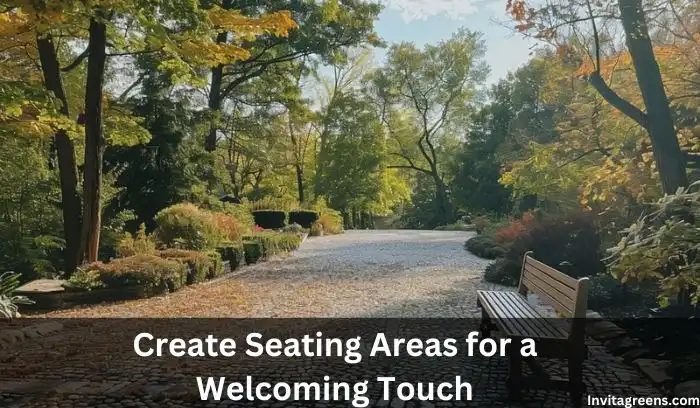
Transform your driveway or its entrance into a space that feels inviting by adding seating areas. These spaces can turn a functional area into something more welcoming and interactive. When choosing locations for seating, think about spots that offer pleasant views and a sense of tranquility.
Whether it’s a shaded spot under a tree, a sunny nook surrounded by fragrant flowers, or a vantage point that highlights a beautiful landscape or a garden feature, these spaces will create a calming and enjoyable atmosphere.
Select outdoor furniture that not only fits the space but also complements the architecture of your home and the overall design theme of your garden. From personal experience, I found that blending the right furniture with natural elements, like a tree or flowers, makes a huge difference in how inviting the space feels. It’s all about creating a place that people will want to spend time in.
16. Plant Hedges to Create a Private Driveway Space
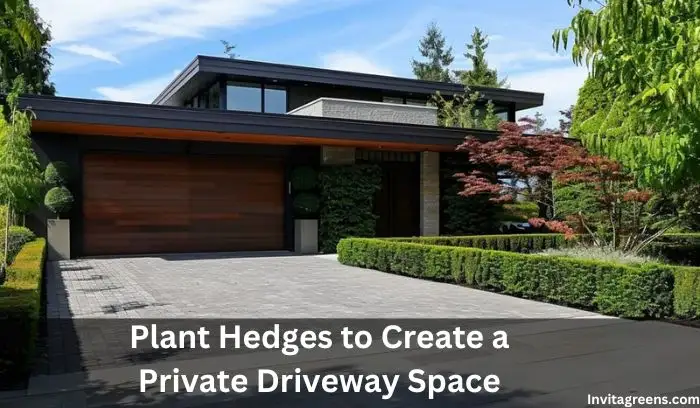
Adding hedges along your driveway is an excellent way to enhance privacy and create a lush, green boundary that provides both function and beauty.
Whether you opt for evergreens like boxwood, yew, or privet, which offer year-round foliage or choose deciduous options such as beech or hornbeam, you can enjoy both structured and aesthetic benefits. The thick, dense nature of these plants forms a natural wall, giving your home an extra layer of seclusion.
Incorporating these plants also adds a dynamic visual element to your landscape. For example, evergreens maintain their color throughout the year, while deciduous plants provide a stunning display of seasonal color changes. From my own experience, planting hedges has dramatically improved the privacy of my driveway, offering a peaceful, secluded space that feels like a retreat.
17. Explore Colored Concrete Pavements to Add Interest to the Driveway
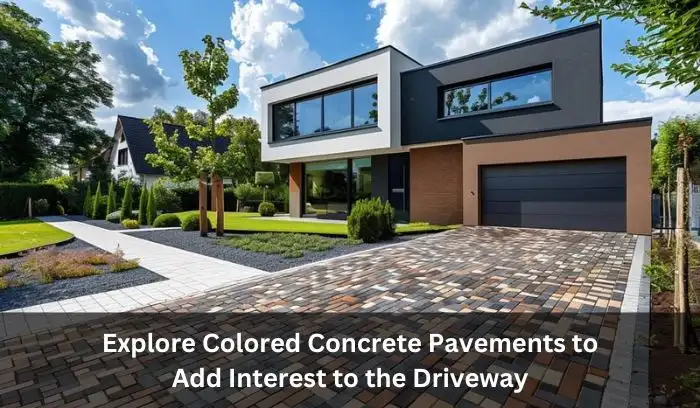
Adding colored concrete pavements to your driveway is a great way to give the space a more distinctive and innovative look. Moving away from the traditional gray, you can choose vibrant colors that bring out a personalized touch to your home.
Whether you prefer earth tones for a more subtle, natural look or vivid hues for a bold and lively appearance, the color you select can greatly influence the overall ambience of the area.
From my own experience, these aesthetically pleasing pavements are not only functional but also transform your driveway into an eye-catching feature. The impact of the right color can enhance your home’s appearance and create a welcoming atmosphere that reflects your unique style.
18. Create a Gated Entrance for Improved Security
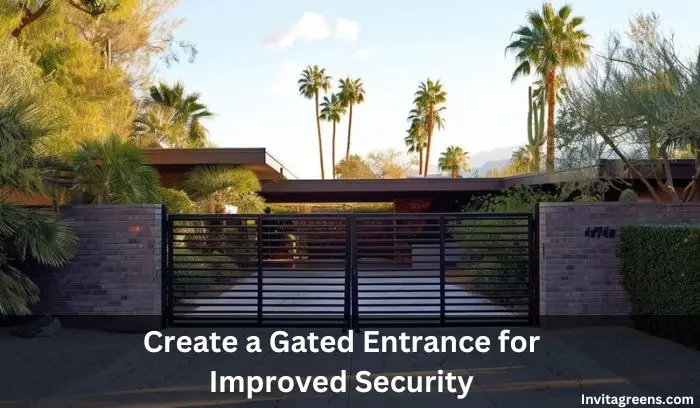
Installing a gated entrance to your driveway can significantly improve both the security and privacy of your property. A well-designed gate adds an element of elegance and distinction, transforming a simple entryway into a statement piece.
You can choose from a variety of materials like wrought iron for a classic, ornate look, wood for a more traditional and warm feel, or modern metals for a sleek, contemporary appearance. Each material offers a different style, allowing you to select one that complements your home’s architecture and the surrounding landscape.
For added convenience and enhanced security, consider installing an automated system for the gate. This system can provide easy access while still maintaining high levels of security. I’ve personally found that having a gate with a reliable automated system creates a perfect balance between privacy and protection while giving a polished and sophisticated appearance to the entrance.
19. Create a Path of Geometric Driveway Pavers
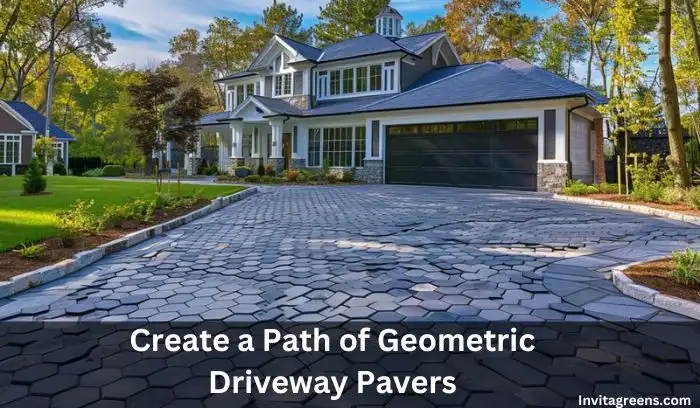
Creating a path with geometric driveway pavers can add a modern and sophisticated touch to your entrance. It combines both functionality and artistic appeal. When selecting a pattern, choose one that complements your home’s architecture.
You can use a variety of geometric shapes such as squares, rectangles, hexagons, or even more unique options like trapezoids. Each shape can bring a different feel to the design.
For a dynamic effect, you might want to try classic patterns like herringbone or basket weave, or opt for a more intricate mosaic-style design. The pattern you choose should harmonize with the overall aesthetic of your landscape, giving your driveway a clean and well-structured look. I’ve personally found that the use of geometric pavers really enhances the appeal of my driveway, making it a striking feature of the home.
20. Plant Colorful and Vibrant Blooms Along the Driveway for a Stunning Look
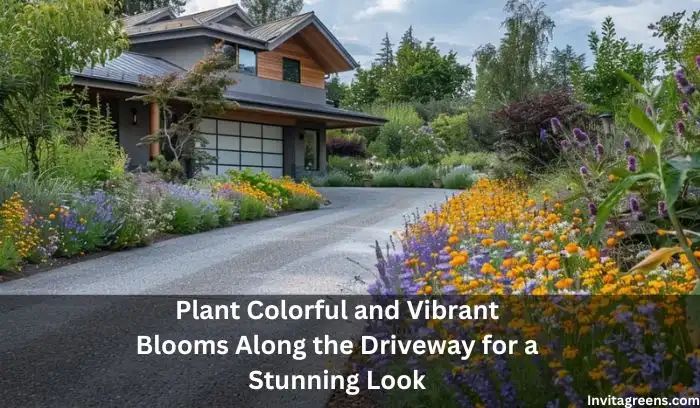
Adding colorful and vibrant blooms along your driveway creates a stunning visual effect that transforms the space into a welcoming corridor. These plants bring an inviting atmosphere that enhances the overall curb appeal of your property.
By incorporating a variety of flowers, you can enjoy a continuous show of color throughout the year. Choose plants that bloom at different times, ensuring that your driveway remains lively and beautiful all year long.
Popular choices for such a garden include daylilies, coneflowers, marigolds, petunias, and lavender.These flowers not only offer striking blossoms but also flourish in various weather conditions. I’ve personally found that selecting plants with staggered blooming times helps create a colorful landscape that keeps your driveway looking fresh and full of life.
21. Install a Water Feature
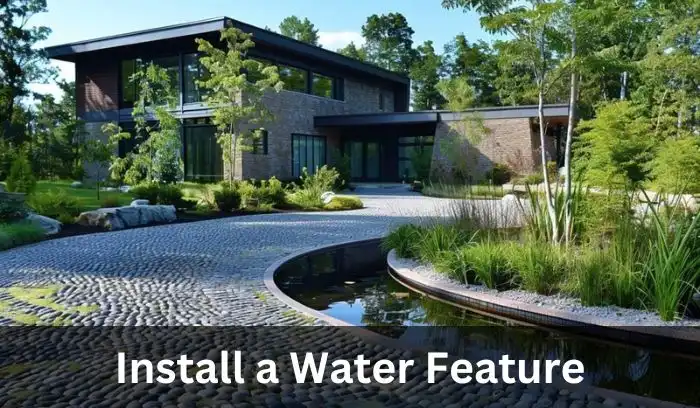
Incorporating a water feature, such as a fountain or a reflective pond, adjacent to your driveway can significantly enhance the luxury and serenity of your residence.
The gentle sound of flowing water adds a calming atmosphere, while its visual charm elevates the overall look of your entrance.
From my experience, the calming effect of a water feature is perfect for transforming a simple driveway into a peaceful retreat.
To fully integrate the water feature into your landscape, surround it with lush plantings or ornamental grasses. These enhancements not only elevate the inherent beauty of the feature but also introduce additional color and texture.
The combination of water, plants, and thoughtful design can really elevate the space and create a relaxing, welcoming environment.
22. Planter Box
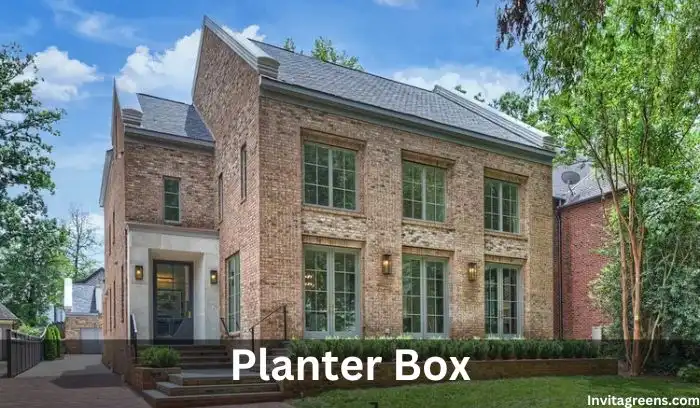
If you have a smaller lawn or limited space in front of your house, adding a planter box is an excellent way to define and separate areas. For example, placing a planter box between the lawn and a cocktail patio can create a distinct boundary while adding a touch of greenery.
It helps make the front of your house feel more organized and structured, especially when the area feels cramped. I’ve seen how much a planter box can elevate the appearance of an outdoor area with just a few simple plants.
Another great way to enhance the look of your space is by adding window boxes. These not only introduce vibrant blooms but also give your home a welcoming, fresh look. Whether placed on the patio or windowsill, planter boxes are a simple yet impactful way to improve curb appeal, even in smaller areas.
23. Wooden Gate

A wooden gate can add significant curb appeal to your home’s landscaping, providing both function and beauty. It’s a perfect addition to your garden, especially when paired with other wood features like a wooden fence or a retaining wall.
The natural look of untreated wood blends beautifully with the surrounding green grass and complements the tones of your house. The way the wood juxtaposes with the vibrant greenery creates a stunning contrast that enhances the overall aesthetic of your property.
From personal experience, I’ve found that the rich, warm hues of wood help soften the cooler tones of a house and provide a welcoming touch to the exterior. Whether you’re creating a small garden or a more grand outdoor entrance, a wooden gate can be a standout feature that adds charm and character to any home.
24. Add Trees for Shade and Privacy
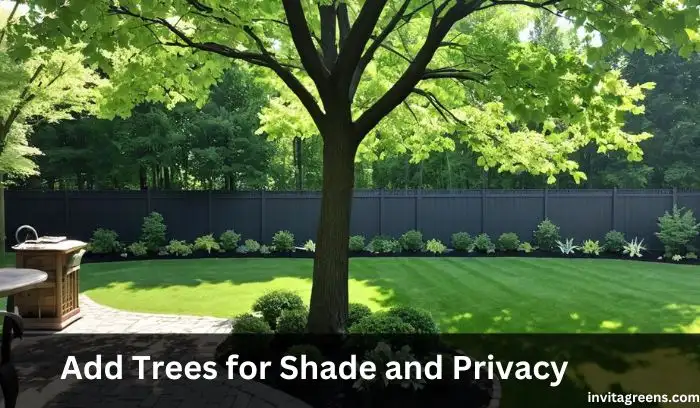
To enhance privacy and provide much-needed shade in your outdoor space, consider planting trees along your driveway or yard. A great choice for this purpose is the Thuja Green Giant, known for its dense foliage, which provides both privacy and a natural barrier.
If you’re looking for variety, the Leyland Cypress and Yew are also fantastic options, offering evergreen coverage that blocks views from outsiders. For added visual appeal, you might opt for a mix of trees like Weeping willow, which offers graceful branches, and the Autumn Blaze maple, known for its stunning fall color.
In addition to creating a natural privacy screen, trees like Holly, Juniper, and Cherry can also add beauty to your landscape. These trees not only provide shade but also offer year-round interest. From my personal experience, planting trees like the Cypress or maple along my property has made a noticeable difference in both the aesthetics and privacy of my yard, making it feel more secluded and inviting.
25. Use Paver Patterns for Interest
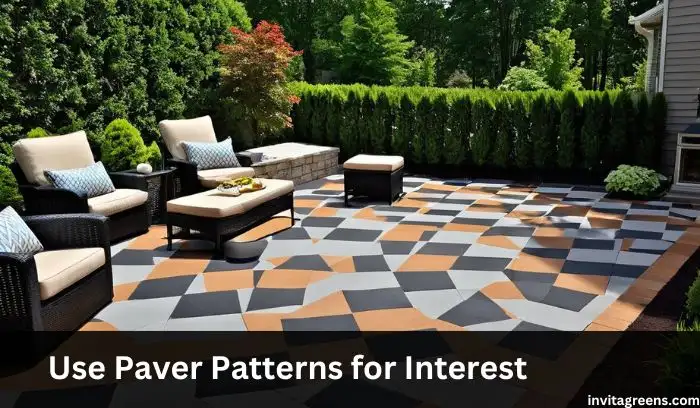
Incorporating paver patterns into your outdoor spaces, like a patio or walkway, can add significant interest and texture. One popular option is the checkerboard pattern, which uses contrasting colors to create a playful yet elegant design.
Another option is the diagonal or slanted pattern, which uses pavers arranged at an angle to create a dynamic and sophisticated look. Personally, I love the zigzag or serpentine patterns because they add movement and dimension to a driveway or garden path.
For a more unique touch, you can experiment with irregular shapes, such as hexagons or octagons, in an asymmetrical arrangement. A mosaic style creates a decorative look by mixing different shapes, while the basketweave pattern alternates between horizontal and vertical pavers, giving it a woven appearance.
If you want a more freeform design, random patterns with different sizes and shapes can give your driveway or walkway an organic, yet balanced, look. I’ve found that using brickwork or herringbone patterns adds timeless charm, while more modern options like the Muster I pattern or casino blend add a sleek, customized feel to any landscape.
26. Add Low-Voltage Lighting
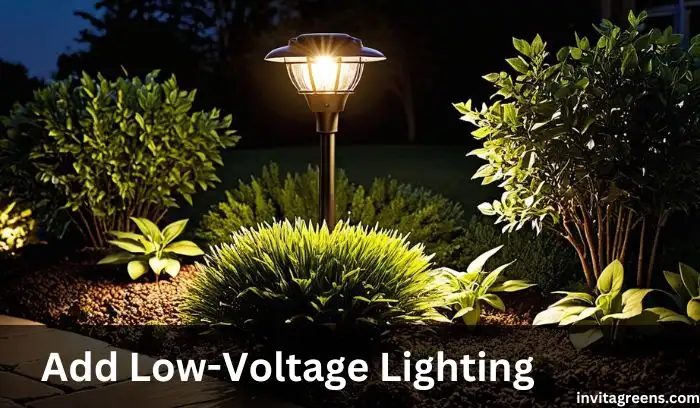
12V is the preferred choice for outdoor lighting in residential areas. This low-voltage system works by converting standard 120V current into 12V using a transformer, making it safe to use in a variety of outdoor settings. The main benefits of low-voltage lighting include the reduced risk of electrical shock, even when used near water or in damp areas.
I’ve personally used low voltage lighting in my backyard and found it to be incredibly safe and efficient. Not only does it provide a soft, warm glow to my outdoor space, but it also offers peace of mind knowing the system minimizes electrical hazards, especially in places where water may be present, like a fountain or garden pond.
27. Plant Ground Cover for a Soft Look
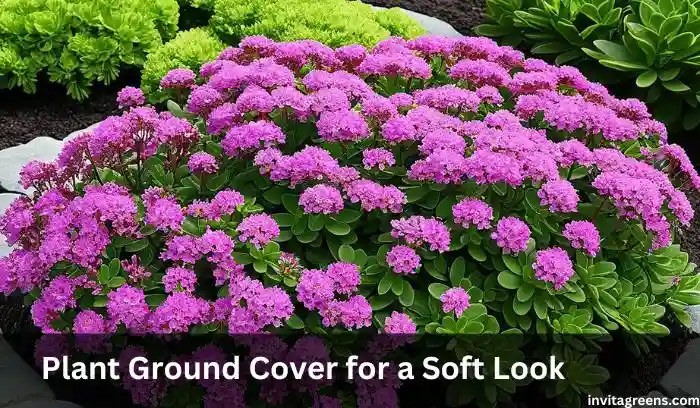
One great way to add a soft look to your landscape is by planting ground cover like sedum and vinca. Sedum has thick, waxy leaves and comes in a variety of colors, offering plenty of options to match your garden’s aesthetic. On the other hand, vinca has softer leaves and fewer color options, making it a perfect choice if you prefer a more subtle look.
Mixing ground cover plants like sedum in the front and adding something taller, like roses, in the back, is often a great choice. This combination helps create layers and adds depth to your garden, with the roses standing out against the softer, lush backdrop of the ground cover. Personally, I’ve found that this layering technique adds a balanced, textured look to any outdoor space.
28. Decorative Driveway Borders
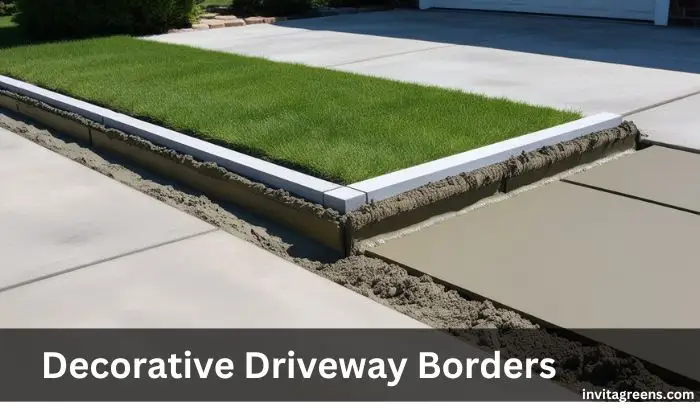
To create decorative driveway borders, the first step is to inspect your driveway edges to ensure they are straight and level. If necessary, dig trenches along the sides of the driveway to prepare for the installation of the borders. Once your trenches are ready, add a layer of concrete that has been mixed to a stiff consistency.
This layer will act as the base for the blocks. Place the blocks against the driveway while the concrete is still wet, ensuring that they stay in place and create a neat, defined edge.
From personal experience, I’ve found that adding a concrete base makes the blocks sturdier, preventing shifting over time. This method not only enhances the aesthetic of the driveway but also ensures that the borders stay in place, creating a clean and stylish finish.
29. Add a Flower Bed
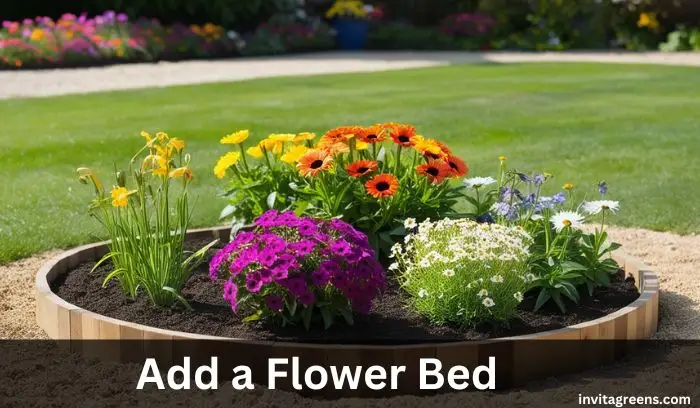
If you want to brighten up your outdoor space, consider adding a flowerbed to your garden or park. Start by selecting an area where the ground is easy to work with.
It’s important to ensure the spot is well prepared so the flowers can thrive and be properly grown. Whether you choose a sunny spot or a shady nook, a carefully planned flowerbed can transform any space into a colorful retreat.
In my experience, even a small flowerbed can make a big difference in the overall look of your outdoor area. With a little effort, you can turn any garden or park into a beautiful display of blooming flowers. Make sure to choose flowers that suit the ground conditions for the best results. A well-prepared area for planting can create a flourishing space that will add natural beauty for months to come.
30. Ribbon Driveway
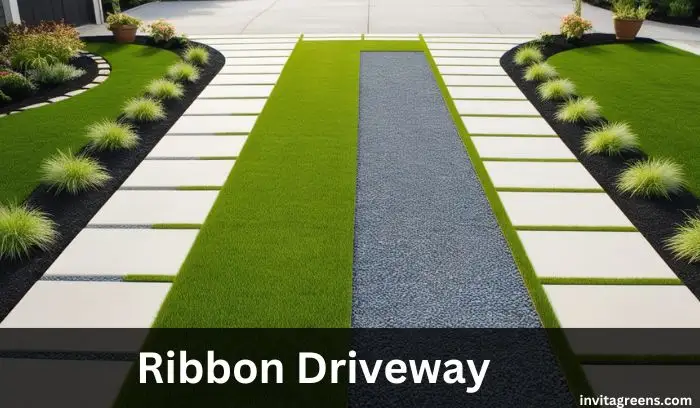
A ribbon driveway, also known as a Hollywood driveway, offers a charming and eco-friendly design for your home. With its unique look, this design features two parallel strips of durable gravel or concrete, leaving the center open for a lush grass area or a small garden.
This strip of greenery not only enhances the visual appeal of the driveway but also brings it to life by blending functionality with nature. Landscape designer Ed Hollander suggests using sod instead of grass seeds, as it establishes more quickly, creating a crisp line while helping to prevent weeds from taking root.
The ground can be designed to accommodate a low-maintenance grass strip or other plants, making it both simple and practical. This design is perfect for homeowners who value aesthetics and sustainability. By incorporating a ribbon driveway, you can enjoy a timeless style that balances modern utility with natural beauty, offering a refreshing change from conventional paved driveways.
How to Maintain Your Driveway Landscaping
A driveway is more than a path to your home; it sets the first impression for visitors. Proper maintenance not only extends its life but also enhances the overall look of your property. Based on my experience, regular cleaning and care help ensure it remains in top condition over the years.
Following expert tips from Lombardo Landscaping & Water Features, Inc., a leading driveway installation company in Fort Myers, FL, I started by sweeping debris and using mild detergents. These simple steps transformed my driveway’s appearance and kept it looking great.
1. Regular Cleaning
Maintaining your driveway in excellent condition begins with consistent cleaning. Begin by removing debris like leaves, rocks, and dirt, which can lead to staining and deterioration over time. For concrete driveways, a power washer is excellent for tackling stubborn dirt and grime, leaving the surface looking new and fresh. If you have asphalt driveways, use a stiff broom to sweep away loose particles and then hose down the area for a clean finish.
Frequent cleaning also gives you the chance to inspect the surface for cracks or damages that may need attention. By addressing these issues early, you can prevent costly repairs and keep your driveway in excellent shape. Whether your driveway is made of concrete or asphalt, a little maintenance goes a long way in preserving its appearance and durability.
2. Sealcoating
Sealcoating is an important maintenance step for maintaining your driveway. For asphalt driveways. applying a protective sealant helps to prevent water penetration, UV damage, and chemical corrosion while restoring the rich black color of the surface. Experts recommend applying a fresh sealcoat every two to three years to protect the integrity of the driveway and extend its lifespan.
For concrete driveways, using a high-quality sealer is equally important to prevent cracking and chipping. This simple maintenance task ensures your driveway remains durable and visually appealing, regardless of its material. Regular sealing safeguards your investment and keeps your property looking its best.
3. Crack Repair
Cracks in your driveway are more than just unsightly—they can serve as entry points for water, leading to serious damage over time. During freeze-thaw cycles, trapped water expands and worsens the problem, making repairs essential. It’s best to fill these cracks as soon as they appear to prevent further deterioration.
To ensure lasting results, it’s wise to consult a professional who can recommend the most appropriate filler to use for your specific driveway material. Addressing cracks promptly not only keeps your driveway looking clean and intact but also protects its long-term durability and function.
Common Mistakes to Avoid in Driveway Landscaping
A common mistake in driveway design is forgetting proper drainage, which causes water issues. Another is making the driveway too narrow, restricting space for vehicles.
Not hiring a professional can ruin your project with costly errors. Avoid these 3 mistakes to ensure a functional and attractive driveway.
1. Forgetting About Drainage
One major mistake that people often make is not thinking about drainage during driveway planning.Water might accumulate on the surface due to poor drainage, causing damage and potentially posing safety issues. Ensuring proper drainage is essential to protect your driveway and maintain its longevity.
To avoid this issue, consider the height, slope, and grading of your driveway so that water drains away properly. Ignoring these factors can result in costly repairs and unsafe conditions, so it’s important to plan carefully from the start.
2. Making the Driveway Too Narrow
While looks are important, it’s easy to forget how the driveway will actually be used. Consider how many cars will need to park there and how often they’ll come and go. A driveway that isn’t wide enough can create frustration and inconvenience, especially if it’s hard to maneuver when multiple cars are parked.
To avoid this, ensure there is an easy way in and way out, even when all spaces are occupied. Proper planning for width and accessibility keeps your driveway functional and avoids future challenges, especially in busy households.
3. Not Hiring a Professional
One of the biggest mistakes you can make when designing your driveway is not hiring an experienced contractor. A good contractor will help you choose the right materials, create a solid design, and handle the construction to ensure your driveway looks great, works well, and follows all necessary rules. Skipping professional guidance can lead to costly errors that are hard to fix later.
With careful planning, you can create a useful and appealing driveway that adds value and curb appeal to your property. With the right expertise, your driveway can be built to last for many years, saving you from unnecessary repairs and enhancing your property.
FAQS
Rupturewort (Herniaria glabra) is the ideal choice for growing grass between pavers. This resilient plant thrives in full sun and part shade, making it perfect for high-traffic areas. It grows well in dry, sandy soil and is suitable for low-maintenance gardens. If you’re looking for a grass that withstands foot traffic and blends beautifully with your landscape, Rupturewort is a great option.
For the best lighting on your driveway, consider in-ground path lights to light up the area. Directional lights are highly effective for illuminating specific spots, while spotlights and wash lights provide broader coverage. For a stylish touch, use wall lighting or fence lighting. Recessed lighting can also be added for a sleek, seamless look. Combining these options will ensure a well-lit and visually appealing driveway.
Increased property value: A landscaped driveway can boost home value by up to 28%.
Improved safety: Strategic lighting makes it safer at night.
Environmental benefits: Trees, shrubs, flowers help reduce pollution and release oxygen.
Reduced flooding: Landscaping controls surface runoff.
Wildlife habitat: Encourages wildlife in your garden.
Curb appeal: Enhances the visual appearance and curb appeal.
Security: Adds extra security, reducing crime and vandalism risks.
To prevent weeds in your driveway, install a weed membrane or geotextile mesh before laying the driveway. Seal any cracks to stop weeds from growing through. Using salt around the edges also helps with prevention. Keep gardening tools clean to avoid spreading seeds and pull any weeds before they can seed.
For low-maintenance driveway landscaping, consider concrete driveways with imprinted slabs. These slabs offer lower maintenance compared to poured concrete and traditional slabs. They reduce weed growth between paving joints, making them easier to care for and more durable. This option combines style with convenience, cutting down on upkeep.
Conclusion
A well-landscaped driveway can create a welcoming first impression. Use perennials, annuals, and ornamental grasses to add charm and elegance. Xeriscaping with drought-resistant plants and efficient irrigation reduces water usage and maintenance. Add height and texture with plants like Miscanthus or Feather Reed Grass, and softer options like Blue Fescue. Consider rock gardens, native plants, and arches for a unique touch that attracts pollinators.
See Also:
38 Types of Palm Trees That Grow Well in Florida (With Picture)
Why Are Seeds Popping Out of the Soil When Worms Fertilize?
Lilies Slow to Break Ground? Here’s Why and How to Fix It!
Are Landscaping and Renovations the Same Thing? A Complete Guide


